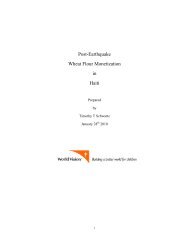Food Consumption Patterns Part 2
You also want an ePaper? Increase the reach of your titles
YUMPU automatically turns print PDFs into web optimized ePapers that Google loves.
110<br />
Annex 2: Proposal<br />
Proposal for Baseline Study of RUFs in Haiti<br />
Submitted Tuesday, June 15, 2014<br />
Timothy T. Schwartz, PhD<br />
timotuck@gmail.com<br />
Summary<br />
1) Review of the literature from academic and NGO sources<br />
2) Interviews at government agencies to collect food related data on laws, regulations and<br />
standards<br />
3) Key informant interviews with members of the business community and researchers with<br />
special knowledge and experience in the area of Haitian nutrition<br />
4) Value chain investigations: specifically into local snack foods, street foods and peanuts<br />
5) Focus groups: total of 33 focusing on nutrition, food consumption, and child feeding practices<br />
6) Frequency List (also referred to as “freelisting”) surveys: 50 lists obtained in association with<br />
focus groups. Focused on ranking of most nutritional foods and snack foods.<br />
7) Qualitative Cultural Consensus Analysis: 49 interviewed in depth using pile sorts (to develop<br />
food categorization profiles/cognitive domains regarding food categories).<br />
8) Quantitative survey on consumption patterns: 128 surveys conducted in association with focus<br />
groups<br />
9) Vendor survey: open interviews with 30 vendors concerning attitudes toward new products,<br />
disposition to purchase, credit arrangements, distribution<br />
10) Boutik surveys: total of 56 boutiks at<br />
11) Boutik Inventories<br />
12) Distributors<br />
13) Redistributors.<br />
14) Quantitative Consumer Survey: 628 respondent survey focusing on snack preferences, prices,<br />
frequency and timing of purchases, attitudes toward local vs. imported foods,<br />
Deliverables<br />
Report that includes: import duties and laws pertaining to nutrition, phytosanitary restrictions,<br />
labeling and packaging. A diagram of ranked distribution mechanisms and map of market chains<br />
and distribution channels and profits at each step in the value chain, market size estimations,<br />
demand, and pricing points. Estimation of wholesale and retail outlets per area and population.<br />
Profile of local food categories, nutritional perspectives and preferences. understanding significant<br />
of fortification, recommendations of how and where the product should be sold, and how to get<br />
the product from importation to the end user. Understanding of storage, transport, and<br />
infrastructure<br />
Materials and programs<br />
The Cultural Consensus Analysis program Analytic Technologies Anthropac; Quantitative<br />
surveys will be conducted with Samsung Tablets programmed in ODK Format with data processed<br />
on Columbia University’s Formhub site.
















